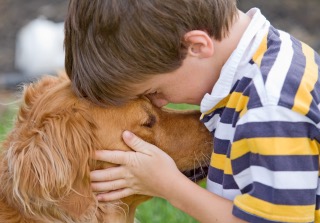Losing a beloved pet can be a challenging experience for anyone, but when it comes to children, the grief can be especially poignant. Losing a pet is often a child’s first experience with death. Explaining the concept of loss and guiding them through the process of mourning is a delicate task for parents, caregivers and the veterinary professionals involved. In this blog post, we explore strategies to help children cope with pet loss, fostering resilience and emotional well-being.
Understanding Children’s Connection with Pets
Children often form strong emotional bonds with their pets. They have likely never experienced life without this beloved pet. The relationship between a child and pet provides companionship, unconditional love, secure attachment, and a sense of responsibility. When a pet passes away, children may experience a range of emotions, from sadness and confusion to guilt or anger.
Honesty and Open Communication
The first step in helping children cope with pet loss is being honest and open about the situation as early as possible. Use age-appropriate language to explain what is happening, ideally, prior to their pet’s passing. Avoid the use of euphemisms, such as “put to sleep”, as these may cause confusion and internal distress. Encourage questions and emotions to be expressed while offering comfort as needed. Validate their emotions by reassuring them that “it’s okay to be sad.”
Provide children the opportunity to be present during the process
In our experience, children appear to do remarkably well when granted the opportunity to be present for the euthanasia of their pet. Parents are in the best position to decide what is best for their child, as well as what is deemed the least stressful for their pet. If possible, have a discussion prior to the appointment itself, to allow a child to decide for themselves if they wish to be present.
Creating Rituals and Memorials
Incorporating rituals or creating memorials can provide a tangible way for children to express their emotions and say goodbye. This could involve holding a small ceremony, planting a memorial tree, or creating a scrapbook of cherished memories with their pet.
Encouraging Expression of Feelings
Children may express their grief in various ways – through tears, drawings, or even play. Encourage them to share their feelings and express their emotions in ways that feel natural to them. Assure them that it’s okay to grieve and that
everyone processes loss differently.
Providing Emotional Support
Offering a supportive environment is crucial during this time. Spend extra time with the child, engaging in activities they enjoy. Reassure them that it’s normal to feel a mix of emotions and that it’s okay to seek comfort from loved ones.
Introducing the Concept of Remembering
Help children shift their focus from the loss itself to positive memories of their pet. Reminisce on happy memories, look at pictures, or create a memory box together. Emphasize that the love they shared with their pet will always be a part of them.
Seeking Professional Help if Needed
If a child’s grief becomes overwhelming or prolonged, it might be beneficial to seek professional support. Child psychologists or counselors experienced in grief can provide guidance and coping strategies tailored to the child’s specific needs. In conclusion, helping children navigate pet loss involves empathy, honesty, and a supportive environment. By acknowledging their feelings, encouraging expression, and fostering positive memories, we can guide them through the grieving process, ultimately promoting emotional resilience. The team at Resting Paws is well equipped to handle these emotional conversations before, during, and after the loss of your pet. Please do not hesitate to reach out for support and guidance. Additional resources for helping children to cope with the loss of their pet can be found on our website under the “Resources” tab and “Pet Loss Support.”
